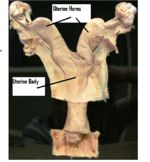Difference between revisions of "Reproductive System Overview - Anatomy & Physiology"
| Line 26: | Line 26: | ||
== Fertilisation, Implantation and Early Embryonic Development == | == Fertilisation, Implantation and Early Embryonic Development == | ||
| − | After mating has occured, sperm must [[Copulation -Sperm in the Female Tract - Anatomy & Physiology|travel]] along the female reproductive tract towards the uterus in order to [[Fertilisation, Implantation and Early Embryonic Development -Fertilisation- Anatomy & Physiology|fertilise]] the oocyte. The sperm | + | After mating has occured, sperm must [[Copulation -Sperm in the Female Tract - Anatomy & Physiology|travel]] along the female reproductive tract towards the uterus in order to [[Fertilisation, Implantation and Early Embryonic Development -Fertilisation- Anatomy & Physiology|fertilise]] the oocyte. The sperm enters the oocyte and the male and female pronuclei fuse and divide repeatedly to form the [[Fertilisation, Implantation and Early Embryonic Development -Embryonic Development of the Blastocyst- Anatomy & Physiology|blastocyst]]. |
| − | |||
| − | |||
| − | |||
* [[Fertilisation, Implantation and Early Embryonic Development -Implantation- Anatomy & Physiology|Implantation]] | * [[Fertilisation, Implantation and Early Embryonic Development -Implantation- Anatomy & Physiology|Implantation]] | ||
Revision as of 17:59, 16 June 2010
|
|
Introduction to the Reproductive System
Reproduction is the complex set of biological processes that result in the formation of a new organism. It is crucial, especially in our production animals, that we understand how these processes occur normally and have a good grasp of the role of hormones in this process. Pathology and disease are common within the reproductive system and can not only lead to a sick animal but also to a loss in production. In this section we hope to cover all the main processes in the domestic animals. This will lay a foundation to aid in the understanding of more potentially quite complex pathologies.
Puberty
Puberty is the process of aquiring reproductive capability, and age at onset of puberty varies from between species. There are several factors involved in triggering the onset of puberty, including body size, nutritional factors, day length, genetic factors and environmental and social factors. The onset depends on the ability of specific hypothalamic neurons to produce gonadotropin-releasing hormone (GnRH) in sufficient quantities to both promote and support gametogenesis. The hypothalamus itself is influenced by hormonal factors that are male or female specific.
Female Reproductive Tract and Reproductive Behaviour
The anatomy of the female reproductive tract includes the the external genitalia and vagina, the cervix, the uterus, the oviduct and the ovary. Female animals regularly enter a phase where they are sexually active and receptive to males; this is collectively known as the oestrous cycle. Some animals are able to reproduce all year round, but many have an anoestrus phase which requires a seasonal response for cycling to begin. In some species detection of seasonal cycling can be crucial to productivity.
Female animals have various behavioural and chemical signals which increase their attractiveness to males and others which signal their acceptance of attention from the male. Further cues indicate that the female is receptive to mating. Other reproductive female behaviours include maternal and nursing behaviour. In neurological terms sensory information from behavioural and chemical cues are processed by the hypothalamus, which induces the appropriate mating response via specific peptides which activate neurons in the midbrain and brainstem.
Male Reproductive Tract and Reproductive Behaviour
The anatomy of the male reproductive tract includes the penis, the testes, the epididymis and the accessory sex glands. Males of different species are often referred to by specific names which reflect their repoductive status. Males differ from females in the production of sperm which takes place from puberty onwards - unlike females where ova are produced prior to birth. The hormones controlling sperm production, or spermatogenesis are luteinising hormone (LH) and follicle-stimulating hormone (FSH).
The neurological pathways that control reproductive behaviour are similar to the female, but the response is male specific and includes pre-copulatory, copulatory and post-copulatory behaviour.
Fertilisation, Implantation and Early Embryonic Development
After mating has occured, sperm must travel along the female reproductive tract towards the uterus in order to fertilise the oocyte. The sperm enters the oocyte and the male and female pronuclei fuse and divide repeatedly to form the blastocyst.
Gestation
Parturition
The Puerperium
- Resumption of Ovarian Function: for more information see 'Species Differences in the Puerperium' below.
Lactation
Reproductive Technologies
Camelids (LLamas & Alpacas)
- Female Anatomy
- Male Anatomy
- Breeding Cycle
- Mating
- Pregnancy Diagnosis
- Parturition
- Lactation & Care of the Newborn
Small Domestic Mammals
- Summary of Reproductive Characteristics for Small Domestic Mammals
- Guinea Pig
- Ferret
- Chinchilla
- Chipmunk
- Mouse
- Hamster
- Rabbit
- Rat
- Gerbil
Exotics
Test yourself - Reproduction System flashcards
References
- P.L Senger: Pathways to Pregnancy and Parturition,2nd Edition
- David E. Noakes,Timothy J. Parkinson,Gary C. W. England,Geoffrey H. Arthur: Arthur's Veterinary Reproduction and Obstetrics
- Bairbre O'Malley:Clinical Anatomy and Physiology of Exotic Species
- Dyce, Sack and Wensing: Textbook of Veterinary Anatomy, 3rd Edition
- Konig and Liebich: Veterinary Anatomy of Domestic Mammals, 3rd Edition
- Victoria Aspinall, Melanie Cappello: Introduction to Veterinary Anatomy & Physiology
- Gina Bromage: Llamas and Alpacas: A Guide to Management
- R.J. Roberts,Lydia Brown: Aquaculture for Veterinarians - Fish Husbandry and Medicine (Pergamon Veterinary Handbook)
- B.Young, J.W Heath: Wheater's Functional Histology, A Text and Colour Atlas
Creators of Reproductive Anatomy and Physiology Pages
- Amy Cartmel (RVC)
- Lois Wilkie (RVC)
